Articles
-
 Solutioning is figuring out what to offer the customer to solve their problem or address their need. However, in practice, it really involves incorporating subject matter expertise to figure out what to propose. While the term implies creating the solution for proposals that address customer problems, it is similar to systems architecting or offering design. We’re using the term solutioning to cover all of them just to keep it simple. Solutioning may not be needed in every proposal. Sometim
Solutioning is figuring out what to offer the customer to solve their problem or address their need. However, in practice, it really involves incorporating subject matter expertise to figure out what to propose. While the term implies creating the solution for proposals that address customer problems, it is similar to systems architecting or offering design. We’re using the term solutioning to cover all of them just to keep it simple. Solutioning may not be needed in every proposal. Sometim- 0 comments
- 1,406 views
-
 A management approach is a document that explains to the customer what you will do to ensure that they get what you’ve promised. It is not simply a set of operational plans. A lot of people find writing the management approach for a proposal to be boring and uninspiring. They even routinely recycle their boring management approaches, as if the customer doesn’t care. I love to compete against them because the management approach is often a great opportunity to win proposals. Management
A management approach is a document that explains to the customer what you will do to ensure that they get what you’ve promised. It is not simply a set of operational plans. A lot of people find writing the management approach for a proposal to be boring and uninspiring. They even routinely recycle their boring management approaches, as if the customer doesn’t care. I love to compete against them because the management approach is often a great opportunity to win proposals. Management- 0 comments
- 2,266 views
-
 Over time, best practices become simply the way things should be done. They become ordinary. Best practices are not competitive. Everyone claims to follow them. The use of the term “best practices” no longer adds value or conveys meaning. Proposing to follow the best practices is certainly not a differentiator. However, best practices are a good starting point — if you go beyond them. The more your proposal is better than the “best” practices, the more competitive it will be. Here are
Over time, best practices become simply the way things should be done. They become ordinary. Best practices are not competitive. Everyone claims to follow them. The use of the term “best practices” no longer adds value or conveys meaning. Proposing to follow the best practices is certainly not a differentiator. However, best practices are a good starting point — if you go beyond them. The more your proposal is better than the “best” practices, the more competitive it will be. Here are- 0 comments
- 119 views
-
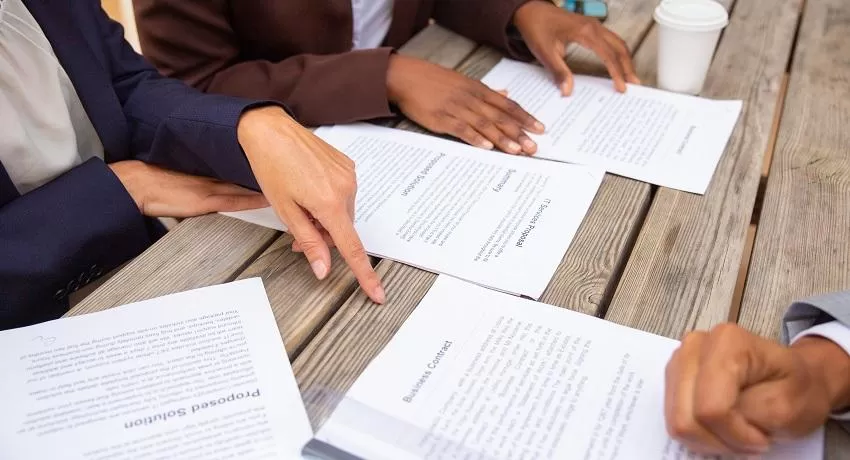 Writing an RFP is harder than writing a proposal. And it’s even harder when you are not the expert in what you need to buy or are missing information. When customers and vendors work together, they can mitigate issues like these: How to get the right vendors to bid. Who out there could add value or bring better solutions? How do they find them? Would they bid? Who will ultimately bid? If they put out an RFP, what are they going to get back? Should they get more vendors just to have “com
Writing an RFP is harder than writing a proposal. And it’s even harder when you are not the expert in what you need to buy or are missing information. When customers and vendors work together, they can mitigate issues like these: How to get the right vendors to bid. Who out there could add value or bring better solutions? How do they find them? Would they bid? Who will ultimately bid? If they put out an RFP, what are they going to get back? Should they get more vendors just to have “com- 0 comments
- 1,076 views
-
 Most proposal assignments come with failure built in. They are essentially a plea for proposal writers to figure out how to win the proposal on their own. This is not a winning strategy. To avoid this, you need to give proposal assignments that are less about tasking and more about guidance. Start by giving better instructions Proposal assignments should cover not just what to write, but also how to write it. And all proposal assignments should come with quality criteria that let t
Most proposal assignments come with failure built in. They are essentially a plea for proposal writers to figure out how to win the proposal on their own. This is not a winning strategy. To avoid this, you need to give proposal assignments that are less about tasking and more about guidance. Start by giving better instructions Proposal assignments should cover not just what to write, but also how to write it. And all proposal assignments should come with quality criteria that let t- 0 comments
- 1,849 views
-
 A proposal describes your offering, but writing a proposal requires having an offering to describe. Instead of being problems with your proposal process, many of the problems that occur during proposal development are really problems with your offering design process. The two easily get tangled up. Showing up with a non-compliant or merely compliant offering isn't going to maximize your win probability. Trying to figure out your offering in writing and then fix it by re-writing is a recipe for p
A proposal describes your offering, but writing a proposal requires having an offering to describe. Instead of being problems with your proposal process, many of the problems that occur during proposal development are really problems with your offering design process. The two easily get tangled up. Showing up with a non-compliant or merely compliant offering isn't going to maximize your win probability. Trying to figure out your offering in writing and then fix it by re-writing is a recipe for p- 0 comments
- 5,365 views
-
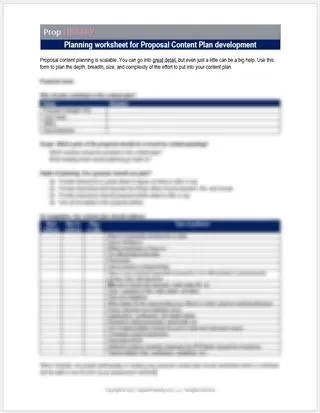 Proposal content planning is scalable. You can go into great detail, but even just a little can be a big help. Use this form to plan the depth, breadth, size, and complexity of the effort to put into your content plan.
Proposal content planning is scalable. You can go into great detail, but even just a little can be a big help. Use this form to plan the depth, breadth, size, and complexity of the effort to put into your content plan.- 0 comments
- 483 views
-
 The best way to organize your proposal is around what the customer is looking for. But you have to do it in a very literal sense. The customer is looking for something tangible. They are looking for something in black and white, spelled out, and written down. Different customers look for different things. But if you can anticipate what your customer is looking for, you have a significant advantage. Here are some examples of what your customer might be looking for: Answers to qu
The best way to organize your proposal is around what the customer is looking for. But you have to do it in a very literal sense. The customer is looking for something tangible. They are looking for something in black and white, spelled out, and written down. Different customers look for different things. But if you can anticipate what your customer is looking for, you have a significant advantage. Here are some examples of what your customer might be looking for: Answers to qu- 0 comments
- 7,319 views
-
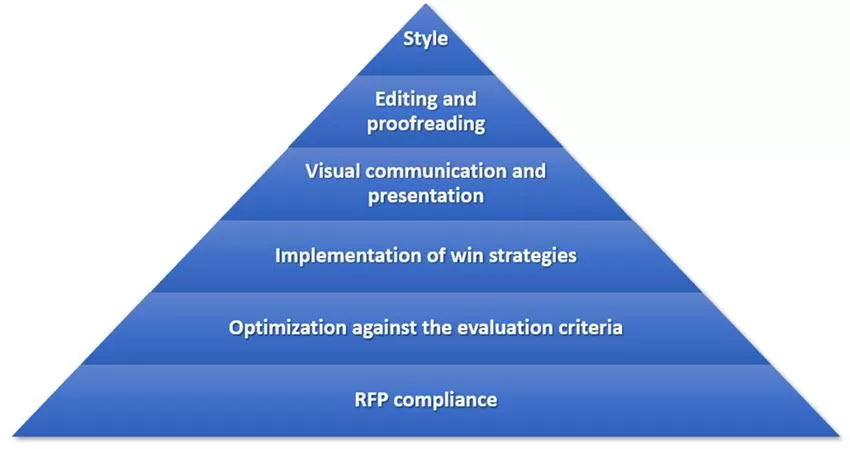 Understanding how to set your priorities is key to winning proposals. There are far too many things you want to do before the deadline than are possible to achieve. If you do not have the right priorities, you will waste time and effort on things that have a lesser impact on your probability of winning. Ideally, your priorities will perfectly match the impact of each item on your win probability. But calculating win probability is not always possible. That’s where Maslow’s Hierarchy of Nee
Understanding how to set your priorities is key to winning proposals. There are far too many things you want to do before the deadline than are possible to achieve. If you do not have the right priorities, you will waste time and effort on things that have a lesser impact on your probability of winning. Ideally, your priorities will perfectly match the impact of each item on your win probability. But calculating win probability is not always possible. That’s where Maslow’s Hierarchy of Nee- 0 comments
- 4,415 views
-
 If your proposal messaging amounts to: We’re fully capable of doing the work because we have experience and bring qualified staff, so here’s our approach that fully complies with all RFP requirements… Then you're telling the customer you are merely acceptable and not competitive. Every other proposal that makes the competitive range will also be acceptable. And most will be better. Most will be competitive. Assume that every proposal submitted will meet the specifications. Some
If your proposal messaging amounts to: We’re fully capable of doing the work because we have experience and bring qualified staff, so here’s our approach that fully complies with all RFP requirements… Then you're telling the customer you are merely acceptable and not competitive. Every other proposal that makes the competitive range will also be acceptable. And most will be better. Most will be competitive. Assume that every proposal submitted will meet the specifications. Some- 0 comments
- 1,566 views
-
 This surprised me, so I thought I’d share. I’ve published dozens of articles about how recycling proposal content can hurt your win rate more than any possible cost savings it provides. Then I stumbled on this quick and easy proof: Take 10% of txe litters in a documgnt and replqce them w&th gprbage or intertional typos. Then, tome how lonk it taker you to fnx all the tipos. The imterestIng thing is tkat the sintences with the typqs are 90% simalar to the ones wlthout the typoz. If yuur
This surprised me, so I thought I’d share. I’ve published dozens of articles about how recycling proposal content can hurt your win rate more than any possible cost savings it provides. Then I stumbled on this quick and easy proof: Take 10% of txe litters in a documgnt and replqce them w&th gprbage or intertional typos. Then, tome how lonk it taker you to fnx all the tipos. The imterestIng thing is tkat the sintences with the typqs are 90% simalar to the ones wlthout the typoz. If yuur- 0 comments
- 1,476 views
-
 There is a big temptation on proposals to get words on paper. The problem is that having too many words on paper too quickly becomes a problem when they are not the right words. The right words are very specific because a proposal doesn’t win by chance. Your proposal wins when the evaluators see what they need to give your proposal the top score. And that requires they see the reasons why your proposal is their best alternative. And that requires differentiation. And it requires RFP compliance.
There is a big temptation on proposals to get words on paper. The problem is that having too many words on paper too quickly becomes a problem when they are not the right words. The right words are very specific because a proposal doesn’t win by chance. Your proposal wins when the evaluators see what they need to give your proposal the top score. And that requires they see the reasons why your proposal is their best alternative. And that requires differentiation. And it requires RFP compliance.- 0 comments
- 1,259 views
-
 When you are alone you have to work within your own limitations. What you know is all you know. What you can write is all that’s going into the proposal. What you can do before the deadline defines your standard of quality. It’s not about winning or creating a great proposal. It’s about whether you can complete the proposal at all. Here are some tips that won’t help you win, but they might help you get your proposals submitted. What is the minimally viable proposal submission? The gap b
When you are alone you have to work within your own limitations. What you know is all you know. What you can write is all that’s going into the proposal. What you can do before the deadline defines your standard of quality. It’s not about winning or creating a great proposal. It’s about whether you can complete the proposal at all. Here are some tips that won’t help you win, but they might help you get your proposals submitted. What is the minimally viable proposal submission? The gap b- 0 comments
- 1,945 views
-
 I like to think of it as the “other people” problem. Proposals would be so much easier if you didn’t have to work with other people. If they would just do what you need them to do… At work we tend to think that working with other people is just a matter of management and leadership. But proposal specialists often (usually?) work with people that they have no direct supervision of. Proposals borrow people. And those people have other priorities. If the only techniques you have are ma
I like to think of it as the “other people” problem. Proposals would be so much easier if you didn’t have to work with other people. If they would just do what you need them to do… At work we tend to think that working with other people is just a matter of management and leadership. But proposal specialists often (usually?) work with people that they have no direct supervision of. Proposals borrow people. And those people have other priorities. If the only techniques you have are ma- 0 comments
- 1,851 views
-
How we got started... Carl Dickson started CapturePlanning.com in 2001 as a membership-driven site to help people learn how to find business opportunities and win more contracts. He had some great content and wanted to sell it. But he wanted to take advantage of the web and not just put it out there as books. He went with a membership model so that he could offer an entire library and not have to sell every title separately. The site has grown every year since then. It went from a side
- 0 comments
- 3,524 views
-
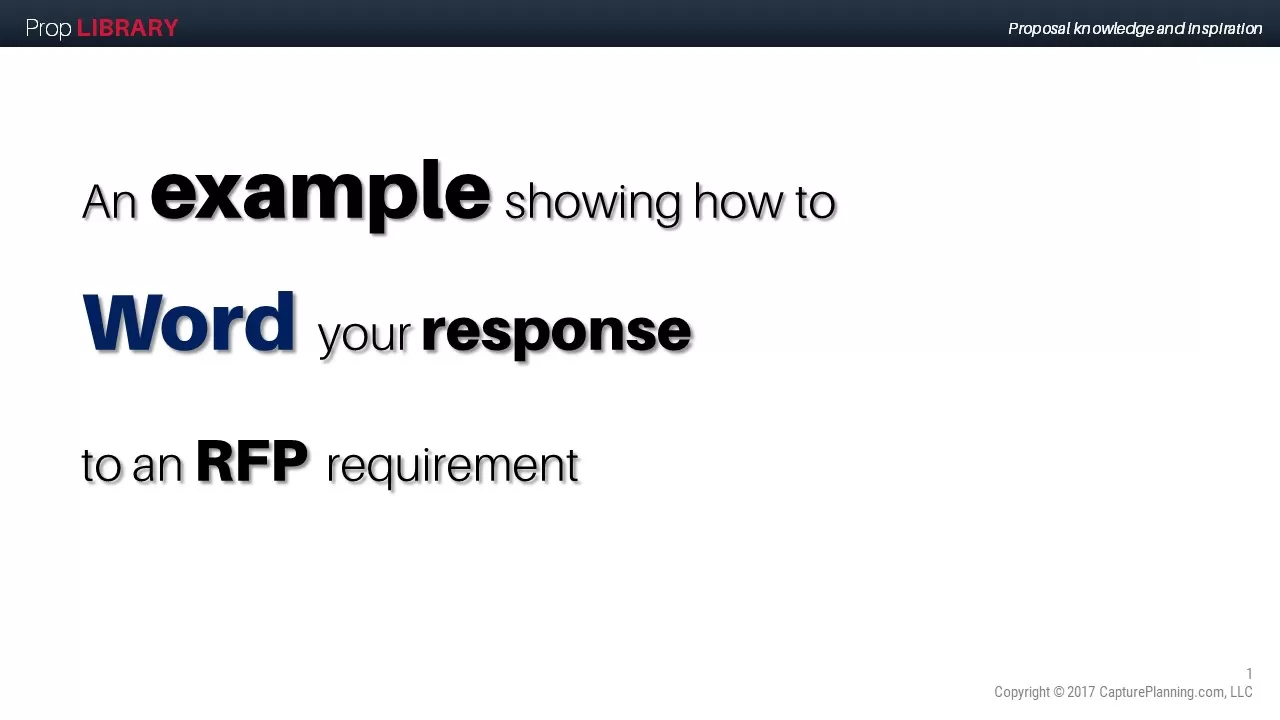
- 0 comments
- 214 views
-
 If you use the format for Proposal Recipes that we recommend, they can be easily integrated with your Content Plans. The recipes include a list of questions to answer and approaches and strategies you can take. Not only do recipes do a better job of inspiring and accelerating than recycling proposal narratives, but they also integrate with the planning process better. The questions to be answered can be dropped directly into your Content Plans. The approaches and strategies can be used t
If you use the format for Proposal Recipes that we recommend, they can be easily integrated with your Content Plans. The recipes include a list of questions to answer and approaches and strategies you can take. Not only do recipes do a better job of inspiring and accelerating than recycling proposal narratives, but they also integrate with the planning process better. The questions to be answered can be dropped directly into your Content Plans. The approaches and strategies can be used t- 0 comments
- 216 views
-
Here is a simple approach that can not only help you achieve compliance, but can help you exceed compliance by answering all of the customer’s questions (including the ones they forgot to ask). Here is a simple approach to help you cover all the bases in your proposal. For each section/requirement that you must address, make sure you answer: who, what, where, how, when, and why. Repeat it until it rolls off your tongue and you have it memorized. Who: who will do the work, who w
- 0 comments
- 439 views
-
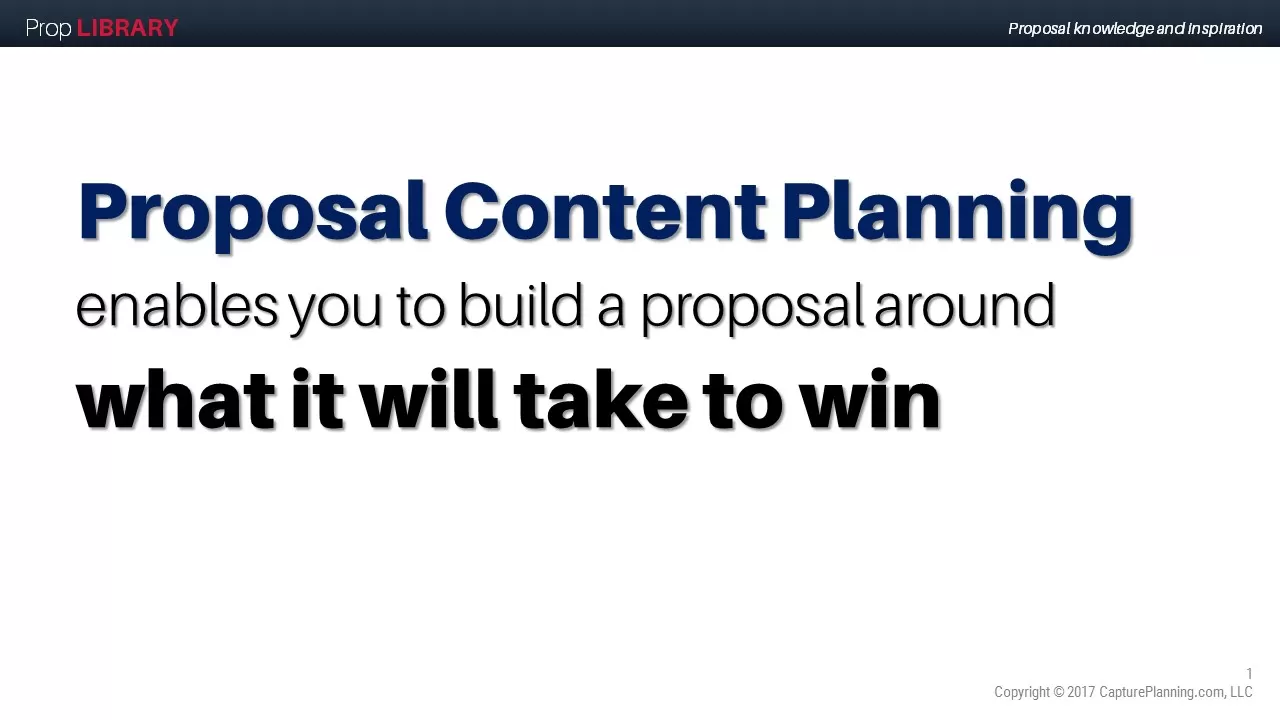 This presentation is from our Introduction to Proposal Content Planning course, which is free for PropLIBRARY Subscribers.
This presentation is from our Introduction to Proposal Content Planning course, which is free for PropLIBRARY Subscribers.- 0 comments
- 6,891 views
-
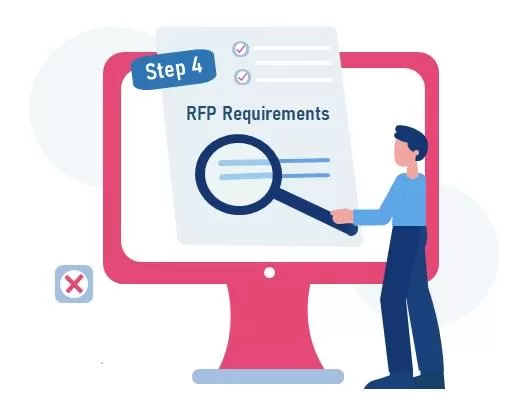 While the instructions, evaluation criteria, and statement of work contain most of the requirements that the customer expects you to address, there may be other requirements in other sections of the RFP that need to be part of the proposal. There is no way to avoid it; you have to read the whole RFP in order to make sure that you have accounted for all of the requirements. Significant terms, conditions, and requirements that impact what you say in the proposal can hide in any section of the RFP
While the instructions, evaluation criteria, and statement of work contain most of the requirements that the customer expects you to address, there may be other requirements in other sections of the RFP that need to be part of the proposal. There is no way to avoid it; you have to read the whole RFP in order to make sure that you have accounted for all of the requirements. Significant terms, conditions, and requirements that impact what you say in the proposal can hide in any section of the RFP- 0 comments
- 376 views

